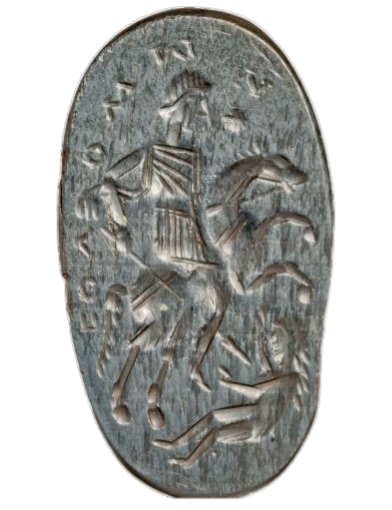
Maureen Attali, 2024
Solomon Spearing a Female Demon on Late Antique Amulets: Shared Traditions and Therapeutic Practices in the Eastern Mediterranean

Obverse of a hematite intaglio featuring a man in Roman garb riding a horse and piercing a long-haired female figure with his lance. On his left, the rider is surrounded with the inscription “Solomon” in Greek. Eastern Mediterranean, 4th–5th century CE. Bibliothèque Nationale de France, département des monnaies, médailles et antiques.
A man in Roman dress on horseback, identified by an inscription as Solomon, pierces a prostrate female figure with a lance. This was engraved on many late antique amulets made of semi-precious stones, metal, glass, or clay. Used by people of various religious backgrounds for healing or protection, amulets, including magical gems, were very popular in the eastern Mediterranean in late antiquity (4th to 7th centuries), whether in the Roman or the Sassanid Empire.
Clues to the meaning of the scene can be found in ancient literature. From the 1st century CE, Jewish writings attributed to Solomon the power to cast out demons that possessed people. The historian Flavius Josephus (Jewish Antiquities 8.45) stated that the biblical king created incantations and exorcisms against demons that were still effective in his lifetime. And indeed, this was the function of amulets: to protect against demons who were thought to be responsible for disease and other misfortunes. Narratives about the king merged with pre-existing shared ritual practices, and iconographic representations of Solomon’s power were imputed with efficacy.
The earliest mention of the king’s confrontation with specifically female demons is found in the Testament of Solomon. The date and authorship of this text, which combines Greek, Jewish and Christian elements and survives in four different Greek versions, is hotly debated; all we know is that it was composed before 400 CE. Solomon is shown questioning demons after God has given him a ring with which to bind them. Among them is Obizuth. Known by hundreds of names, she is described as having unbound hair, like the female figure on the amulet. Obizuth targets pregnant women and newborn babies; she also admits that she can be defeated by amulets. As these characteristics were attributed to Lilith in late ancient Jewish literature and inscriptions, descriptions of the amulet often refer to the female figure as Lilith. Stories of Solomon defeating demons, whether male or female, then proliferated in Jewish, Christian, and later Muslim traditions, with the Qur’an stating that Solomon received the power to control djinns (34:12–13, surah Saba).
The scene composition of the amulet is derived from an iconographic model used in various historical and mythical episodes. Depictions of the hero Bellerophon sitting on Pegasus and piercing the chimera, a creature made up of the body parts of a lion, a goat, and a snake, were popular from the 7th and 5th century BCE until Late Antiquity. Gods such as Horus in the Sudan and Jupiter in Gaul were depicted in a similar pose as they defeated reptilian creatures. This iconography was then re-used for saints credited with similar feats: the famous episode of George of Lydda slaying a dragon became a staple of Christian art from the 11th century onwards.
The standard amulet image of a horseman spearing a demoness does not contain any specific religious markers except, in our example, a reference to a biblical figure – Solomon – who was famous and considered powerful even by those who did not regard the Bible as sacred. In addition, late antique amulets are known to combine texts and images associated with different religious backgrounds: Egyptian, Greek, Jewish and Christian, including groups commonly known as “Gnostics”. They also often refer to representations shared across religious boundaries, such as demons and the evil eye. It is therefore virtually impossible to determine the religious identity of amulet makers and users based on their content.
Our amulet is the product of multiple processes of co-production. Its co-produced iconography was used to represent co-produced traditions about the king’s powers; it was employed in co-produced therapeutic practices that gave efficacy to certain gestures, words, and images.
Many people did regard the amulet’s co-produced status as a guarantee of its efficacy, as attested by the creation of new transcultural figures, such as the Anguipede; this cock-headed and snake-legged human in armour, who holds a whip in one hand and a shield in the other, combined elements from various religious backgrounds. Some specimens do, however, bear specific religious markers. The accompanying ritual formula ssny, which often appeared on Solomon-versus-demoness amulets, was sometimes interpreted as the name “Sisinnius”. This Sisinnius was then identified with the successor of Mani and became a Christian saint. “Christian” versions of the amulet thus supplement or replace Solomon’s name with Sisinnius and add other Christian markers such as Christograms. It therefore appears that some sought to use amulets to reinforce religious boundaries.
Regardless, the popularity of such objects and the use of co-produced imagery demonstrate how the yearnings and anxieties of religious subjectivity transcend religious communal boundaries.
Further reading:
Dasen, Véronique, and Árpád M. Nagy. “Chapter 17 Gems”. In Guide to the Study of Ancient Magic, edited by David Frankfurter, 416–55. Leiden: Brill, 2019.
Mastrocinque, Attilio. Les intailles magiques du département des Monnaies, médailles et antiques. Paris: Bibliothèque nationale de France, 2014.
Shalev-Eyn, Sarit. “Solomon, his Demons and Jongleurs: The Meeting of Islamic, Judaic and Christian Culture.” Al-Masaq 18, no. 2 (2006):145–160.
Spier, Jeffrey. “Medieval Byzantine Magical Amulets and Their Tradition.” Journal of the Warburg and Courtauld Institutes 56 (1993): 25–62.
Tardieu, Michel. “La nisba de Sisinnios.” Altorientalische Forschungen 18, no. 1 (1991): 3–8.
Torijano, Pablo A. Solomon the Esoteric King. From King to Magus, Development of a Tradition. Leiden: Brill, 2002.
Verheyden, Joseph (ed). The Figure of Solomon in Jewish, Christian and Islamic Tradition: King, Sage, and Architect. Leiden: Brill, 2013.